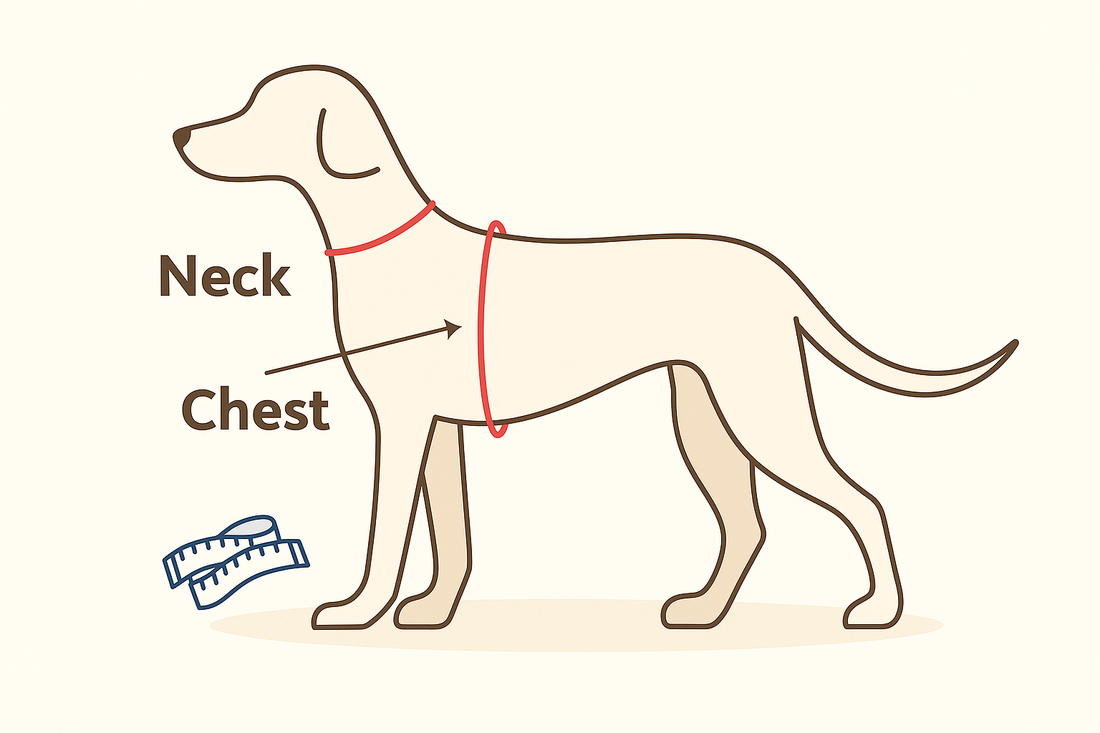
The Ultimate Guide: How to Measure Your Dog for the Perfect Harness Fit
Share
As a responsible dog owner, finding the right harness for your furry companion is crucial. A well-fitted harness not only ensures your dog's comfort but also plays a vital role in their safety during walks and outdoor adventures. But how do you navigate the world of dog harnesses and find that perfect fit? In this comprehensive guide, we'll walk you through the process of measuring your dog for a harness, ensuring you get the ideal size every time.
Why Proper Harness Fit Matters
Before we dive into the nitty-gritty of measurements, let's understand why a well-fitted harness is so important for your canine friend:
- Comfort: A properly fitted harness allows your dog to move freely without chafing or restriction. This comfort is essential, especially during longer walks or active play sessions.
- Safety: A snug (but not tight) fit prevents your dog from slipping out during walks. This is particularly crucial in high-traffic areas or when encountering unexpected situations.
- Training: The right fit can make leash training more effective and enjoyable for both you and your pup. It provides better control without causing discomfort.
- Health: An ill-fitting harness can cause skin irritation, restrict breathing, or even lead to muscle strain. A proper fit supports your dog's natural movements and posture.
- Confidence: Dogs feel more secure in a well-fitted harness, which can boost their confidence during walks and social interactions.
Essential Tools for Measuring Your Dog
Before you start measuring, gather these items:
- Soft measuring tape (or a piece of string and a ruler)
- Pen and paper to note measurements
- Treats to keep your dog calm and cooperative
- A helper, if possible, to assist in keeping your dog still
Step-by-Step Measuring Guide
1. Measure the Chest Girth
The chest girth is the most critical measurement for most harness types. Here's how to measure it accurately:
- Find the widest part of your dog's chest, usually right behind the front legs.
- Wrap the measuring tape around this area, making sure it's snug but not tight.
- The general rule of thumb is you should be able to fit two fingers (side by side) underneath the strap.
- If using string, mark where it overlaps and measure that length with a ruler.
- Record this measurement as the chest girth.
Pro Tip: For dogs with deep chests (like Greyhounds or Whippets), take an additional measurement at the deepest part of the chest to ensure a proper fit.
2. Measure the Neck Girth
While not all harnesses require neck measurements, it's useful information to have:
- Measure around the base of your dog's neck, where a collar would typically sit.
- Ensure you can comfortably fit two fingers between the tape and your dog's neck.
- Record this as the neck girth.
3. Measure the Back Length (for some harness styles)
Some harness styles, particularly those with back plates, require a back length measurement:
- Measure from the base of the neck (where the collar sits) to the base of the tail.
- This measurement helps ensure the harness doesn't extend too far down your dog's back.
4. Weigh Your Dog
While not a direct measurement, knowing your dog's weight can be helpful:
- Use a bathroom scale if your dog is small enough to hold.
- For larger dogs, weigh yourself first, then weigh yourself holding your dog, and calculate the difference.
- Many harness sizing charts include weight ranges along with measurements.
Tips for Accurate Measurements
Measuring an excited or wiggly dog can be challenging. Here are some tips to help you get accurate measurements:
- Measure your dog when they're standing up straight on all fours.
- Take each measurement 2-3 times to ensure accuracy.
- If possible, measure your dog when they're calm, perhaps after a walk or playtime.
- Use treats to keep your dog in position and reward their patience.
- If your dog is particularly active, consider measuring them when they're slightly tired.
- For long-haired dogs, make sure the measuring tape is against their skin, not just on top of the fur.
Choosing the Right Harness Style
Now that you have your measurements, consider which harness style suits your dog best:
- Step-in Harnesses: Great for dogs who don't like things going over their head. These harnesses typically require accurate chest measurements.
- Over-the-Head Harnesses: Often provide more security and are easier to put on for some dogs. These usually need both chest and neck measurements.
- Front-Clip Harnesses: Ideal for dogs who pull on the leash. These harnesses often require precise chest and sometimes neck measurements.
- Back-Clip Harnesses: Good for trained dogs who don't pull excessively. These typically need accurate chest girth measurements.
- Dual-Clip Harnesses: Versatile options that allow for both front and back clipping. These usually require comprehensive measurements for a proper fit.
What If Your Dog Falls Between Sizes?
It's not uncommon for dogs to fall between standard harness sizes. In these cases:
- Usually, it's best to choose the larger size and adjust the harness accordingly.
- Look for harnesses with multiple adjustment points for a more customized fit.
- Consider brands that offer in-between sizes or custom sizing options.
The Importance of Regular Re-Measuring
Your dog's size can change over time due to factors like age, diet, and activity level. It's important to:
- Re-measure your dog every 6-12 months.
- Check the fit of the harness regularly, especially if you notice any changes in your dog's body condition.
- Replace the harness if you notice signs of wear and tear, as this can affect the fit and safety.
Conclusion: Ensuring Comfort and Safety for Your Canine Companion
Measuring your dog for a harness might seem daunting at first, but with these simple steps, you'll be able to find the perfect fit. Remember, a well-fitted harness ensures your dog's comfort and safety during all your adventures together. It's an investment in your dog's well-being and your peace of mind.
Ready to find the perfect harness for your pup? Check out our selection of adjustable, comfortable harnesses at Little Pickle.
By taking the time to measure your dog correctly and choose the right harness, you're setting the stage for enjoyable walks, successful training sessions, and countless happy adventures with your four-legged friend. Happy measuring, and even happier walking!
